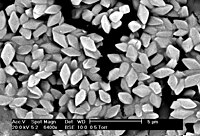
Photo from wikipedia
Cry proteins from Bacillus thuringiensis (Bt) have been used to control insect pests either as formulated sprays or as in Bt-crops. However, field-evolved resistance to Bt proteins is threatening the… Click to show full abstract
Cry proteins from Bacillus thuringiensis (Bt) have been used to control insect pests either as formulated sprays or as in Bt-crops. However, field-evolved resistance to Bt proteins is threatening the long-term use of Bt products. The SeABCC2 locus has been genetically linked to resistance to a Bt bioinsecticide (Xentari™) in Spodoptera exigua (a mutation producing a truncated form of the transporter lacking an ATP binding domain was found in the resistant insects). Here, we investigated the role of SeABCC2 in the mode of action of Cry1Aa, Cry1Ab, Cry1Ac, Cry1Ca, and two Cry1A-1Ca hybrids by expressing the receptor in Sf21 and HEK293T cell lines. Cell toxicity assays showed that Sf21 cells expressing SeABCC2 become susceptible to Cry1A proteins. HEK293T cells expressing the transporter were found susceptible to Cry1A proteins but not to Cry1Ca. The results with the Cry1A-1Ca hybrids suggest that domain II from Cry1Ab/c is crucial for the toxicity to Sf21 cells, whereas domain III from Cry1Aa/b is crucial for the toxicity to HEK293T cells. Binding assays showed that the Cry1Ac binding is of high affinity and specific to cells expressing the SeABCC2 transporter. Heterologous competition experiments support a model in which domain II of Cry1Ab/c has a common binding site in the SeABCC2 protein, whereas domain III of Cry1Aa/b binds to a different binding site in the SeABCC2 protein.
Journal Title: Insect biochemistry and molecular biology
Year Published: 2018
Link to full text (if available)
Share on Social Media: Sign Up to like & get
recommendations!